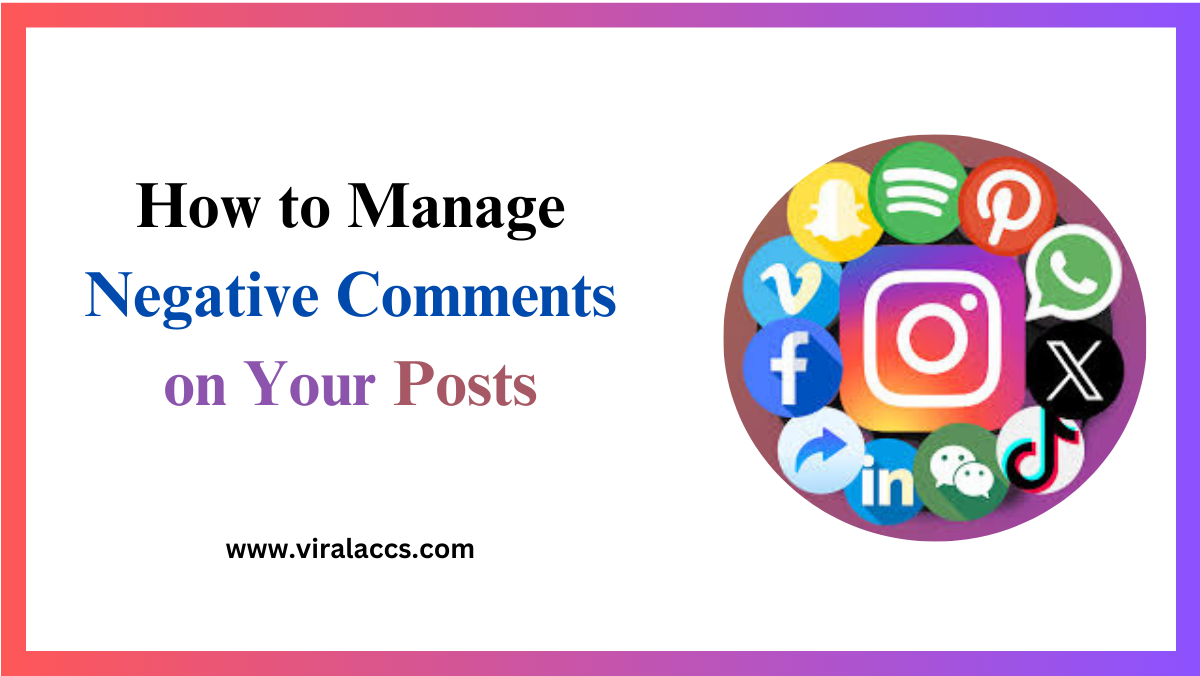The digital age has transformed the way we communicate, connect, and conduct business. Social media platforms have become a crucial space for brands to engage with their audience, share content, and promote products. However, with this increased visibility comes the inevitable challenge of managing negative comments. Handling these comments effectively is essential for maintaining your brand’s reputation and fostering a positive online community.
In this comprehensive guide, you’ll learn strategies to manage negative comments on your posts, turn these situations into opportunities, and safeguard your brand reputation. Whether you’re a seasoned marketer or a small business owner, this post will provide valuable insights to help you handle negativity with grace and professionalism.
Understanding Negative Comments on Your Posts
Negative feedback can come in many forms, from constructive criticism to outright trolling. Understanding the nature of these comments on your posts is the first step in managing them effectively.
Types of Negative Comments
Negative comments on your posts can be broadly classified into three categories:
- Constructive Criticism: These are comments on your posts that highlight genuine issues or concerns with your product or service. They often come from loyal customers who want to see improvements.
- Complaints: These comments express dissatisfaction with a particular aspect of your business, such as customer service, product quality, or delivery times.
- Trolling and Spam: These comments are often malicious and aim to provoke or disrupt. They may contain offensive language and lack any constructive purpose.
Recognizing which type of negative comment you’re dealing with is crucial for crafting an appropriate response.
The Impact of Negative Comments
Negative comments on your posts can have a significant impact on your brand’s reputation. Studies show that consumers are more likely to share negative experiences than positive ones, amplifying the potential damage. According to a survey by BrightLocal, 82% of consumers read online reviews for local businesses, highlighting the importance of managing online feedback effectively.
Why Negative Feedback is Inevitable
No matter how excellent your product or service is, negative feedback is inevitable. It’s essential to accept that negative comments on your posts are a part of doing business in the digital age. The key is not to avoid them but to manage them in a way that minimizes damage and maximizes learning opportunities.

Strategies for Responding
Responding to negative comments on your posts requires a thoughtful approach. Here are some strategies to help you handle them effectively:
Stay Calm and Professional
It’s natural to feel defensive when faced with negative comments, but it’s crucial to stay calm and professional. Take a deep breath and approach the situation objectively. Remember, your response reflects on your brand.
Address the Issue Promptly
Responding promptly shows that you value customer feedback and are committed to resolving issues. A quick response can prevent the situation from escalating and reassure other customers that you take their concerns seriously.
Acknowledge and Empathize
Start your response by acknowledging the customer’s concern and expressing empathy. This helps to defuse tension and shows that you care about their experience. For example, “I’m sorry to hear that you had a negative experience. We appreciate your feedback and want to make things right.”
Turning Negatives into Positives
Negative comments can be turned into opportunities for growth and improvement. Here’s how:
Use Feedback to Improve
Constructive criticism can provide valuable insights into areas where your business can improve. Use this feedback to make necessary changes and enhance your product or service.
Showcase Your Customer Service
Handling negative comments effectively can showcase your customer service skills. A well-crafted response can demonstrate your commitment to customer satisfaction and build trust with your audience.
Build a Positive Community
By addressing negative comments openly and professionally, you can foster a positive online community. Encourage satisfied customers to share their positive experiences to balance out the negativity.
Setting Guidelines for Responses
Having clear guidelines for responding to negative comments ensures consistency and professionalism. Here are some key points to include in your guidelines:
Establish a Tone of Voice
Define a consistent tone of voice for your responses. This should align with your brand’s overall communication style. Whether it’s formal, friendly, or humorous, ensure it’s appropriate for the situation.
Create a Response Template
Develop response templates for common types of negative comments. This can help your team respond quickly and consistently. Customize these templates as needed to address specific concerns.
Empower Your Team
Ensure that your customer service team is well-trained and empowered to handle negative comments. Provide them with the resources and authority to resolve issues efficiently.
Monitoring Brand Reputation
Regularly monitoring your brand’s reputation is essential for proactive management of negative comments. Here’s how to stay on top of your online presence:
Use Social Listening Tools
Social listening tools like Hootsuite, Sprout Social, and Brandwatch can help you track mentions of your brand across social media platforms. These tools provide real-time alerts, allowing you to address issues promptly.
Monitor Review Sites
Keep an eye on review sites like Yelp, Google Reviews, and Trustpilot. Respond to reviews promptly and professionally, whether they’re positive or negative.
Engage with Your Audience
Regularly engage with your audience on social media. Respond to comments, participate in discussions, and show appreciation for positive feedback. Building a strong relationship with your audience can mitigate the impact of negative comments.
Learning from Negative Comments
Negative comments, while initially distressing, can be instrumental in shaping a better business strategy. Embracing negative feedback allows companies to identify underlying issues that may not have been visible from the inside. This proactive approach can lead to crucial changes that enhance customer experience and satisfaction.
- Implement Regular Feedback Loops
Establishing regular feedback loops with customers can facilitate ongoing dialogue. Consider conducting surveys or initiating focus groups to delve deeper into customer opinions. This method not only provides insights on specific issues but also demonstrates to customers that their opinions are valued.
- Encourage Constructive Conversations
Fostering an environment where customers feel comfortable sharing their thoughts can lead to a more positive interaction overall. Encouraging constructive conversations through various channels can turn negative experiences into valuable discussions that enhance brand loyalty. By promoting open channels of communication, brands can create a supportive community that welcomes both positive and constructive feedback.
By integrating these practices into your overall business strategy, you can transform negative comments into significant opportunities for improvement and growth.
Conclusion
Managing negative comments on your posts is a critical aspect of reputation management in the digital age. By understanding the nature of negative feedback, responding thoughtfully, and turning negatives into positives, you can maintain a positive online presence and build trust with your audience. Establishing clear guidelines for responses and regularly monitoring your brand’s reputation will further enhance your ability to handle negativity effectively.
Remember, negative comments are an opportunity for growth and improvement. By addressing them with professionalism and empathy, you can turn challenges into opportunities and strengthen your brand’s reputation.
If you’re looking for more personalized guidance, consider scheduling a consultation with our team of experts. We’re here to help you master the art of managing negative comments and build a thriving online community.








